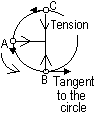Phys2
FORCES
-can change; size + shape of an object, direction of movement of an object, speed of an object

Hooke's Law: when a spring is fixed at one end & a force is exerted on the other end the extension produced by the spring is proportional to the force, provided that the elastic limit is not exceeded (stretching the spring permanently), elastic limit = limit of proportionality [F = ke, F = force, k = constant, e = extension]
Newton's 1st Law: a body stays at rest , or if moving, it continues to move w/ uniform velocity in a straight line unless an external force causes it to behave differently
force ^ > acc. ^ [(a proportional to F)(mass-constant)] Mass ^ > acc. decrease [(a inversely proportional to m)(force-constant)] a is proportional to F/m
Newton's 2nd Law: 1N is defined as the force which gives a mass of 1kg an acceleration of 1m/s, F = ma
Friction- force which opposes motion, arises from contact bet. 2 surfaces
reduce friction-smoothen / lubricate surfaces or separate surfaces from making direct contact (put air in between, hovercraft) Friction needed for walking, braking, parachutes, etc.
Circular motion- objects which move in a circle
When a ball is in circular motion (vertical), direction = tangent to circle
ball accelerating (direction changes); must be a force acting on it (F = ma): F acts towards centre of circle = centripetal force, arises from tension in string
[centripetal force = tension + weight of object (ball: vertically above centre) or tension - weight (ball: vertically below centre)]
centripetal force increases when : radius decrease, mass of object increased, speed increased

(centripetal force at C = tension in string + weight of object, centripetal force at B = tension in string - weight of object)
Scalars and Vectors
scalar quantity-magnitude only
vector quantity-complete only when magnitude & direction is mentioned (represented by a straight line, length = magnitude, arrow = direction)
Addition of vectors
Parallelogram Law: if 2 vectors acting at a pt are represented in size & direction by sides of a parallelogram drawn from a pt, resultant represented in size & direction by diagonal of parallelogram, drawn from the same pt

Centre of gravity- pt. where whole weight of an object seems to act
If pivoted on it, the object balances [if object not too large; centre of gravity = centre of mass]
regular-shaped laminas(a thin plane sheet)- intersection of diagonals or medians or lines of symmetry
irregular-shaped laminas-use a plumbline
Locating centre of mass using a plumbline
centre of mass = intersection of lines

Stability- objects ability to maintain its original position
object falls if vertical line through centre of mass falls outside base
increase stability; lower c.g. + wider base
stable equilibrium- body displaced slightly > return to original position
unstable equilibrium- body displaced > move further (topple over)
neutral equilibrium- body displaced > remains in new position, c.g. doesn't rise or fall

Moments
Moment or torque of a force = turning effect of a force, moment of a force = force x perpendicular dist from force to pivot (F x d)
Principle of moments
-a body is in equilibrium when sum of clockwise moments = sum of anti-clockwise moments, about the same pt
Conditions for equilibrium:
1 sum of forces in one direction = sum of forces in opposite direction
2 sum of clockwise moments = sum of anti-clockwise moments about the same point
Energy
Pressure
Light
Magnetism
Electrostatic Charging
Electricity
Thermal Physics
Waves & Sound
Radioactivity
Measurements in Physics
Back to 'O' level notes index
Back to notes index




